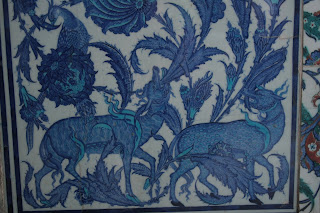Topkapi Palace was the home of the Sultans from 1465 until 1856 when Dolmebaçe became the official residence. The Palace was built by Sultan Mehmet II, who conquered Constantinople, but the original structures were added to by subsequent Sultans. At its height it held 4000 people, and its kitchens are the origin of Turkish cuisine for which I am particularly grateful.
Visiting Topkapi includes walking through its impressive courtyard, viewing the distinguished buildings and rooms but particularly admiring its many artifacts, including ornate robes of the Sultans across the centuries, the porcelain, the jewels, the Sultan's bed (larger than king size), while imagining the culture and army that sustained this dynasty for 600 years.
Among these many delights, it was the tile in the Circumcision room (also known as the Summer study) that I enjoyed. The room was open, airy, had a wonderful view of the Bospherus and if I did not think about the surgical procedure at least by name once practiced there, then I could imagine my self happily ensconced in that room above all others. The tile work is phenomenal and so I share some of the pictures taken here.
Many of the tiles were moved from other parts of the palace built by Sultan Suleiman I, to honor his greatness–and presumably lineage.
These large panels, influenced by far Eastern ceramics, are considered some of the most important tile work in the room and, possibly, even the palace. They date from 1529 and are remarkable in size and beauty.






No comments:
Post a Comment